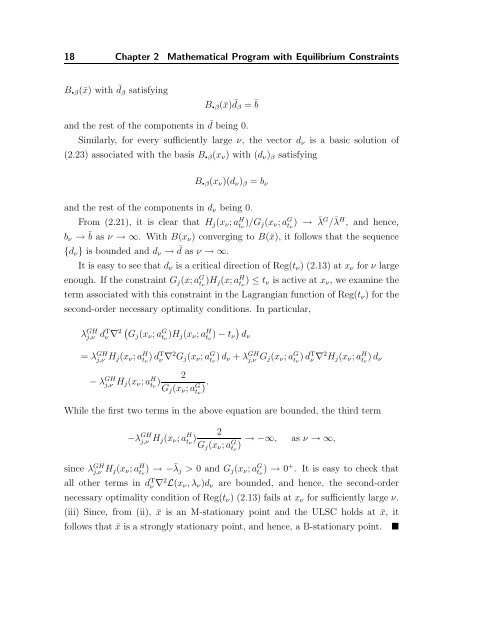equilibrium problems with equilibrium constraints - Convex ...
equilibrium problems with equilibrium constraints - Convex ...
equilibrium problems with equilibrium constraints - Convex ...
Create successful ePaper yourself
Turn your PDF publications into a flip-book with our unique Google optimized e-Paper software.
18 Chapter 2 Mathematical Program <strong>with</strong> Equilibrium Constraints<br />
B. β (¯x) <strong>with</strong> ¯d β satisfying<br />
B. β (¯x) ¯d β = ¯b<br />
and the rest of the components in ¯d being 0.<br />
Similarly, for every sufficiently large ν, the vector d ν is a basic solution of<br />
(2.23) associated <strong>with</strong> the basis B. β (x ν ) <strong>with</strong> (d ν ) β satisfying<br />
B. β (x ν )(d ν ) β = b ν<br />
and the rest of the components in d ν being 0.<br />
From (2.21), it is clear that H j (x ν ; a H t ν<br />
)/G j (x ν ; a G t ν<br />
) → ¯λ G /¯λ H , and hence,<br />
b ν → ¯b as ν → ∞. With B(x ν ) converging to B(¯x), it follows that the sequence<br />
{d ν } is bounded and d ν → ¯d as ν → ∞.<br />
It is easy to see that d ν is a critical direction of Reg(t ν ) (2.13) at x ν for ν large<br />
enough. If the constraint G j (x; a G t ν<br />
)H j (x; a H t ν<br />
) ≤ t ν is active at x ν , we examine the<br />
term associated <strong>with</strong> this constraint in the Lagrangian function of Reg(t ν ) for the<br />
second-order necessary optimality conditions. In particular,<br />
λ GH<br />
j,ν d T ν ∇ 2 ( G j (x ν ; a G t ν<br />
)H j (x ν ; a H t ν<br />
) − t ν<br />
)<br />
dν<br />
= λ GH<br />
j,ν H j(x ν ; a H t ν<br />
) d T ν ∇2 G j (x ν ; a G t ν<br />
) d ν + λ GH<br />
j,ν G j(x ν ; a G t ν<br />
) d T ν ∇2 H j (x ν ; a H t ν<br />
) d ν<br />
− λ GH<br />
j,ν H j(x ν ; a H 2<br />
t ν<br />
)<br />
G j (x ν ; a G t ν<br />
) .<br />
While the first two terms in the above equation are bounded, the third term<br />
j,ν H j(x ν ; a H 2<br />
t ν<br />
)<br />
G j (x ν ; a G t ν<br />
)<br />
−λ GH<br />
→ −∞, as ν → ∞,<br />
since λ GH<br />
j,ν H j(x ν ; a H t ν<br />
) → −¯λ j > 0 and G j (x ν ; a G t ν<br />
) → 0 + . It is easy to check that<br />
all other terms in d T ν ∇2 L(x ν , λ ν )d ν are bounded, and hence, the second-order<br />
necessary optimality condition of Reg(t ν ) (2.13) fails at x ν for sufficiently large ν.<br />
(iii) Since, from (ii), ¯x is an M-stationary point and the ULSC holds at ¯x, it<br />
follows that ¯x is a strongly stationary point, and hence, a B-stationary point.
















